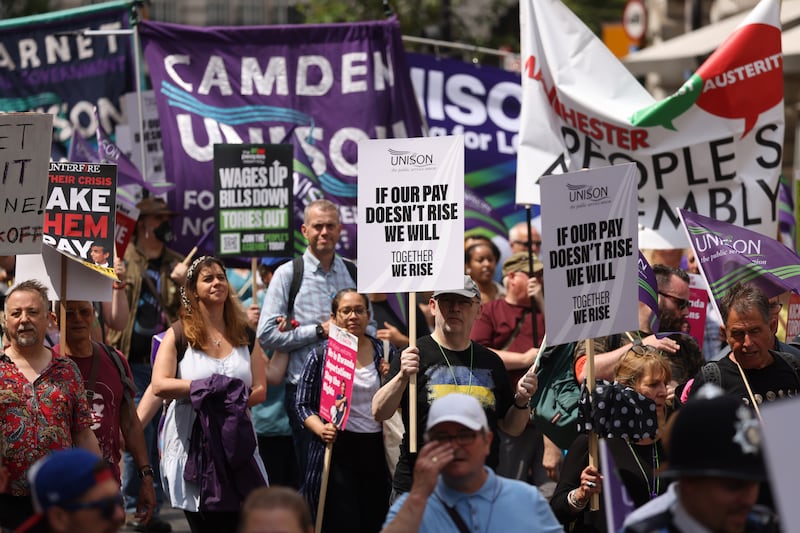UK workers already facing a cost-of-living squeeze saw their pay lag behind record-level inflation over the past quarter, according to official figures.
The Office for National Statistics (ONS) said regular pay, excluding bonuses, grew by 4.7 per cent over the three months to June.
Analysts had predicted that wages would increase by 4.5 per cent.
The announcement came after CPI inflation hit a new 40-year record of 9.4 per cent in June and is expected to peak at about 11 per cent later this year.
The ONS said this resulted in a 3 per cent drop in regular pay for employees once inflation is taken into account, representing the biggest slump since records began in 2001.
Meanwhile, the unemployment rate increased to 3.8% for the quarter compared with 3.7% for the previous period.
The Bank of England recently increased interest rates by 0.5 percentage points with more rises expected as it tries to drag inflation back to its target of 2 per cent.
Figures earlier this month showed that the UK economy contracted by 0.1 per cent between April and June, driven by a decline in spending by households and on fighting coronavirus, compared with growth of 0.8 per cent in the previous three months.
Official figures also showed today that the number of UK workers on payrolls rose by 73,000 between June and July to 29.7 million.
ONS director of economic statistics Darren Morgan said: “The number of people in work grew in the second quarter of 2022, whilst the headline rates of unemployment and of people neither working nor looking for a job were little changed.
“Meanwhile, the total number of hours worked each week appears to have stabilised very slightly below pre-pandemic levels.
“Redundancies are still at very low levels.
“However, although the number of job vacancies remains historically very high, it fell for the first time since the summer of 2020.”
Asked on BBC Radio 4’s Today programme if vacancies in the labour market have peaked, Mr Morgan said: “There’s been a lot of talk about whether vacancies have peaked … they did fall by a little bit in the latest three months, but the important thing to flag I think is that they still remain at historically high levels.
“There still remains a vacancy for every person unemployed, and that’s astonishing isn’t it? And that’s only happened for the first time in recent months,” he said.
In response to the latest labour market figures from the ONS, Chancellor Nadhim Zahawi said: “Today’s stats demonstrate that the jobs market is in a strong position, with unemployment lower than at almost any point in the past 40 years ― good news in what I know are difficult times for people.
“This highlights the resilience of the UK economy and the fantastic businesses who are creating new jobs across the country.”
Return of foreign workers
The ONS statistics also showed that Britain recorded its biggest rise in foreign workers since the start of the Covid-19 pandemic in the year to June, driven overwhelmingly by workers from outside the European Union.
Since January 2021, most EU citizens not already working in Britain must be sponsored by an employer and be paid a salary that does not significantly undercut existing wages, after losing their previous almost-unrestricted right to work.
The post-Brexit change puts EU migrants on the same footing as those from the rest of the world, but has drawn complaints from employers who find the process bureaucratic, and a non-starter for most jobs that pay less than £25,600 ($30,760) a year.
Tuesday's Office for National Statistics data showed the number of foreign-born workers in Britain rose by 223,000 in the year to the end of June, up from an increase of 184,000 in the year to March and the biggest rise since early 2020.
"Migration - a key source of worker shortages through the pandemic - is showing some signs of bouncing back," said James Smith, an economist at ING.
Samuel Tombs, at Pantheon Macroeconomics, said migration was likely to rise further as the salary thresholds for sponsoring work visas had not been raised in line with average wages, which are 5.1 per cent higher than a year ago.






